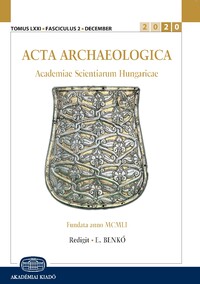Lány – ein Produktionsort gegossenener Bronzen der Spätawarenzeit in der awarisch-slawischen Kontaktzone des unteren Thayatals
Lány - a production site for cast bronzes from the late Avar period in the Avar-Slavic contact zone of the lower Thaya valley
Author(s): Jiří Macháček, Stefan Eichert, Adéla Balcárková, Petr Dresler, Radek Měchura, Peter Milo, Mathias MehoferSubject(s): Archaeology
Published by: Akadémiai Kiadó
Keywords: early medieval archaeology; Avar belt accessories; bronze casting; transfer of technology; slavic pottery
Summary/Abstract: Interdisciplinary research, carried out by the Masaryk University Brno and the University of Vienna, at the site of Lány (CZ) at the border between Austria and Moravia has revealed a large settlement (∼12ha) from the 6th century until the 8th/9th century in a contact zone between Slavonic and Avarian influences. Aside from pottery that ranges from early slavic finds of the Prague type to specimens of the middle-danubian tradition („mitteldanubische Kulturtradition“) and other finds such as spindle whorls etc. several dozen typical Avar belt accessories have been found. Most of them date to the late Avar III period, are brand new and do not show any traces of usage. Together with semi-finished products, miscast objects and remains of the bronze casting process, we interpret Lány as a production site/workshop for Avar belts. Lány is at the very Northwestern periphery of the Avar Khaganate. However, material culture, aside from the belt accessories, is much more associated with what we know from regions where Slavonic populations of the 7th/8th century had settled. We furthermore discuss the usage of Avar belts amongst the Slavic elites of the 8th century and possible explanations for the dense distribution of Avar finds outside of the Khaganate.
Journal: Acta Archaeologica Academiae Scientiarum Hungaricae
- Issue Year: 72/2021
- Issue No: 2
- Page Range: 365-416
- Page Count: 52
- Language: German
- Content File-PDF

